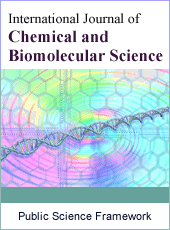International Journal of Chemical and Biomolecular Science
Articles Information
International Journal of Chemical and Biomolecular Science, Vol.1, No.4, Dec. 2015, Pub. Date: Sep. 13, 2015
Nutritional and Mineral Composition of the Fruits of Solanum torvum from Ghana
Pages: 222-226 Views: 7016 Downloads: 3466
[01]
Osei Akoto, Department of Chemistry, Kwame Nkrumah University of Science and Technology, Kumasi, Ghana.
[02]
Lawrence Sheringham Borquaye, Department of Chemistry, Kwame Nkrumah University of Science and Technology, Kumasi, Ghana.
[03]
Ama Samba Howard, Department of Chemistry, Kwame Nkrumah University of Science and Technology, Kumasi, Ghana.
[04]
Niib Konwuruk, Department of Chemistry, Kwame Nkrumah University of Science and Technology, Kumasi, Ghana.
The fruits of Solanum torvum are regularly used in many Ghanaian food preparations because of the belief that they are very nutritious. The main aim of this work was to assess the nutritional and mineral composition of the Solanum torvum fruits. Proximate analyses of dried powdered fruits were therefore performed. The results indicated that the fruits possess high moisture content (86.230%). The values for the other parameters checked were carbohydrates 7.033%, proteins 2.322%, fats 0.278%, ash 0.143% and crude fiber 3.993%. Atomic Absorption Spectroscopy (AAS) analysis of essential minerals was performed to ascertain the concentrations of iron, manganese, calcium, copper and zinc in the fruit. The results were iron (76.869mg/kg), manganese (19.466mg/kg), calcium (221.583mg/kg), copper (2.642mg/kg) and zinc (21.460mg/kg). Vitamins A and C contents were also analyzed and found to be 0.078mg/100g and 2.686mg/100g respectively. The high iron content of the fruits proves the fact that, the fruits truly have hematinic property.
Atomic Absorption Spectrophotometry, Proximate Analysis, Vitamins, Iron Rich Fruits
[01]
Adjanohoun J.E., Aboubakar N, Dramane K, Ebot M.E., Ekpere J.A., Enoworock E.G., Foncho D, Gbile Z.O., Kamanyi A., Kamoukom Jr, Keeta A, Mbenkum T, Mbi C.M., Mbielle A.L., Mbome I.L., Mubiru N.K., Naney W.L., Nkongmeneck B, Satabie B, Sofowa A, Tanze V, and Wirmum C.K. 1996. ‘Traditional Medicine and Pharmacopeia- Contribution to Ethnobotanical and Floristic Studies in Cameroon.’ In CNPMS, 50–52. Porto-Novo, Benin.
[02]
Ahamad, M.N. and Saleemullah, M. 2007. ‘Determination of Beta Carotene Content in Fresh Vegetables Using High Performance Liquid Chromatography.’ Sarhad Journal Of Agriculture 23 (3): 767–70.
[03]
Al-Shawi, A., R., Obaid, J., A., and Noor, H., M. 2012. ‘Study of the Incidence and Types of Anemia in Pregnant Women in Bagdad Province.’ Journal of University of Anbar for Pure Science, 6 (1): 600–604.
[04]
Al-Jameil, N, and H Tabassum. 2014. ‘Analysis of Serum Trace Elements-Copper, Manganese and Zinc in Preeclamptic Pregnant Women by Inductively Coupled Plasma Optical Emission Spectrometry.’ International Journal of Clinical and Experimental Pathology 7 (5): 1900–1910.
[05]
Asiedu-Darko, E. 2010. ‘A Survey of Indigenous Knowledge about Food and Medicinal Properties of Solanum Torvum in East Akim District of Eastern Region of Ghana.’ Ghana Journal of Agricultural Science 43 (5): 61–64.
[06]
Bhagyashree, M, Jogen K, Sharma, K. and Babul, S. 2012. ‘Proximate Nutiritive Values and Mineral Components of Solanum Torvum (berries).’ Novel Science International Journal of Pharmaceutical Science 1: 449–51.
[07]
Chah, K.F., Muko, K.N. and Oboegbulem S. I. 2000. ‘Antimicrobial Activity of Methanolic Extract of Solanum Torvum Fruit.’ Fitoterapia 71: 187–89.
[08]
Howard, RA. 1989. ‘Flora of the Lesser Antilles, Leeward and Windward Islands. 3: Dicotyledoneae.’ Jamaica Plain, MA: Arnold Arboretum.
[09]
Koffuor, G. A, Amoateng, P. and Andey, T. A. 2011. ‘Immunomodulatory and Erythropoietic Effects of Aqueous Extract of the Fruits of Solanum Torvum Swartz (Solanaceae).’ Pharmacognosy Research 3 (2): 130–34.
[10]
Langeland, K.A. and Burks, K.C. 1998. Identification & Biology of Non-Native Plants in Florida’s Natural Areas. Gainesville, Florida, United States.
[11]
Liogier, A.H. 1995. Descriptive Flora of Puerto Rico and Adjacent Islands.
[12]
Little, E. L., Jr., Woodbury R. O. and Wadsworth, F. H. 1974. ‘Trees of Puerto Rico and the Virgin Islands. Second Volume.’, no. 449.
[13]
Mohan, M, and Bhandare S. 2012. ‘Protective Effect of Solanum Torvum against Testicular Toxicity in Male Wistar Rats.’ International Journal of Pharmacy and Pharmaceutical Sciences 4 (3): 188–92.
[14]
Nagababu, E, Gulyani, S. and Earley C. J. 2008. ‘Iron-Deficiency Anaemia Enhances Red Blood Cell Oxidative Stress.’ Free Radical Research 42 (9): 824–29.
[15]
Sundari, G., S., Rekha, S., and Parvathi, A. 2013. ‘Phytochemical Evaluation of Three Species of Solanum L.’ International Journal of Research in Ayurveda and Pharmacy 4 (3): 420–25.
[16]
Tapia, A., R., Astudillo, A., V., & Uribe, R., H. 1996. ‘New Paper.’ In Resultados Preliminaries Del Efetco de Solanum Torvum Plantago Major Sobrela Proliferación de Células Hematopoyéticas in Vivo E in Vitro, 102–4. Tlaxcala, Tlax., Mexico.
[17]
WHO. 2000. Malnutrition, the Global Picture. Geneva.

ISSN Print: 2381-7372
ISSN Online: 2381-7380
Current Issue:
Vol. 5, Issue 2, June Submit a Manuscript Join Editorial Board Join Reviewer Team
ISSN Online: 2381-7380
Current Issue:
Vol. 5, Issue 2, June Submit a Manuscript Join Editorial Board Join Reviewer Team
| About This Journal |
| All Issues |
| Open Access |
| Indexing |
| Payment Information |
| Author Guidelines |
| Review Process |
| Publication Ethics |
| Editorial Board |
| Peer Reviewers |


